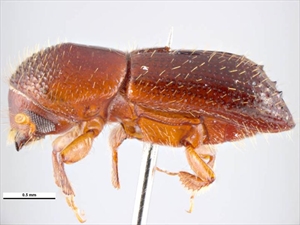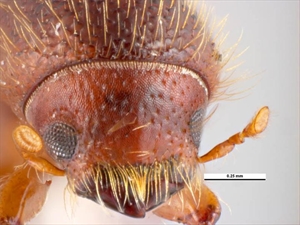Island pinhole borer. It is also known as ambrosia beetle, bark beetle, coconut shot-hole borer, and shot-hole beetle. The common name, ambrosia beetle, belongs to a number of related species. Ambrosia beetles cultivate fungi as their sole food source in the tunnels they make in distressed trees.
Pacific Pests, Pathogens and Weeds - Online edition
Pacific Pests, Pathogens & Weeds
Island pinhole borer (482)
Xyleborus perforans; previously known with other species names, and also placed in other genera, e.g., Anodius, Bostrichus and Tomicus.
Asia, Africa, North America, Europe (restricted), Oceania. It is recorded from Australia, American Samoa. Cook Islands, Federated States of Micronesia, Fiji, French Polynesia, Guam, Kiribati. Marshall Islands, New Caledonia, New Zealand, Niue, Northern Mariana Islands, Palau, Papua New Guinea, Samoa, Solomon Islands, Tonga, and Vanuatu
A very large number of hosts are attacked: forest and plantation species in many plant families; commodities (e.g., betel nut, cashew, coconut, coffee, macadamia, rubber); fruit trees (e.g., avocado, citrus, jackfruit, mango, papaya), some members of the grass family (e.g., sugarcane); ornamental trees; and weeds.
This ambrosia beetle does not attack healthy living trees; it attack those that have been injured (e.g., by disease or fire), are dying or have been felled. It also attacks recently sawn timber.
Eggs are laid in branching tunnels that penetrate deep into the wood, where all stages - larval, pupal and adult - develop over a period of 4-6 weeks. The larvae and adults feed on ambrosia fungus introduced by the beetles into the tunnels to provide food. The beetles have pockets in their mandibles that store fungal spores and cottony growth, and these are released, inoculating the tunnels as they chew their way into the tree.
The adults are about 2.8 mm long, red-brown, darker on the wing cases (Photos 1-3).
More females develop than males, they are polygamous, and the offspring mate together. After mating and already fertilized, females emerge to seek new breeding sites. Spread is by flight over short distances, and by the trade in logs and timber, as well as the movement of bark, dunnage (loose wood to keep cargoes in place) and pallets, between countries.
The economic impact of the beetle is not well documented, but it is likely that the heavy attacks reported on newly felled trees and sawn untreated timber is considerable. The pinholes and fungal staining that occur around the tunnels, results in considerable wastage as the wood cannot be used for furniture or veneer. However, the strength of the timber is not affected by the presence of the holes.
Look for the presence of pinholes and frass made during tunnelling. Look for the beetles in their galleries, but with so many similar beetles in the ambrosia group, expert advice will be needed to determine the different species.
BIOSECURITY
The risk of introduction to countries not yet infested by the beetle is high; this is because it is able to attack many different hosts, tolerate a wide range of environmental conditions, and sisters mate with brothers. Consequently, countries should consider all likely pathways of entry, and apply quarantine measures accordingly. Particular attention should be given to the trade in logs and timber. Xyleborus spp. are included in the APHIS Regulated Pest List in the USA, and are quarantine pests in New Zealand.
In those countries yet free from ambrosia beetle, traps baited with ethanol should be placed at ports to monitor for its presence and, if detected, surveys carried out to determine the extent of infestation, and if eradication is a possibility. Ensure crates, pallets and dunnage are compliant with the International Standards for Phytosanitary Measures No. 15: Guidelines for regulating wood packaging material in international trade (ISPM 15): (http://www.fao.org/3/a0450e/a0450e.pdf).
CULTURAL CONTROL(ISPM 15):
In those countries where the beetle is already present, it is most important that felled trees are removed as quickly as possible from logging areas to reduce infestations, and that they are converted to appropriately seasoned sawn timber.
CHEMICAL CONTROL
Insecticides are unlikely to prevent infestations of logs or unseasoned sawn timber as the beetles are often deep inside and protected from their actions.
AUTHOR Grahame Jackson
Information from CABI (2020) Xyleborus perforans (island pinhole borer) Crop Protection Compendium. (https://www.cabi.org/cpc/datasheet/57169); and from Walker K (2006) Island pinhole borer (Xyleborus perforans). PaDIL - (http://www.padil.gov.au). Phots 1-3 Walker K (2006) Ibid.
Produced with support from the Australian Centre for International Agricultural Research under project HORT/2016/185: Responding to emerging pest and disease threats to horticulture in the Pacific islands, implemented by the University of Queensland and the Secretariat of the Pacific Community.






